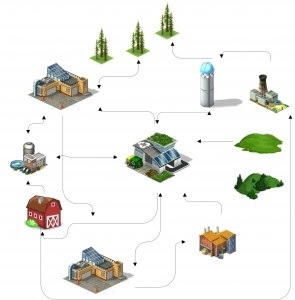Industrial symbiosis
Industrial symbiosis is a form of brokering to bring companies together in innovative collaborations, finding ways to use the waste from one as raw materials for another.
Industrial symbiosis entails local partnerships under which partners share and reuse resources for the purpose of creating common value. Its aim is to create a chain of technical and biological materials with the intention of minimal loss and waste production.
The word “symbiosis” is usually associated with relationships in nature, where two or more species exchange materials, energy, or information in a mutually beneficial manner.
Local or wider co-operation in industrial symbiosis can reduce the need for virgin raw material and waste disposal, thereby closing the material loop. It constitutes a fundamental feature of the circular economy and a driver for green growth and eco-innovative solutions. It can also reduce emissions and energy use and create new revenue streams.
The need for industrial symbiosis stems from the shortage of global resources and increasing prices of raw materials, which increase the demand for a circular approach in the production sector. Cooperation and exchange of materials, water and energy improves the perseverance and economic benefits of companies, while reducing the environmental impact and costs. However, establishing industrial symbiosis requires more than just standing up for one another and the environment. It calls for constant search of better business solutions.

The world’s first industrial symbiosis concept originates from Denmark and is called the Kalundborg Symbiosis (1961). It is a collaboration of nine public and private enterprises. The Kalundborg Symbiosis has evolved over the course of six decades, creating joint projects in areas where the business model and cooperation can be utilised in the context of industrial symbiosis. This results in annual financial and socio-economic gain, a reduced carbon footprint and savings on water, energy and materials. Read more about the Kalundborg Symbiosis.
The concept of industrial symbiosis has also been implemented in Estonia, the greatest example is the PAKRI Science and Industrial Park in Paldiski. It is focused on the green technology sector, covering areas such as renewable energy, energy-efficiency of buildings, smart-grid, smart-city, energy storage, electric vehicles and green fuel. The autonomic smart-grid, which is currently in development, consisting of a wind and solar park and a biomass-based cogeneration plant shall offer a significant competitive advantage thanks to its 25 MW capacity. PAKRI Science and Industrial Park, which was established in 2007, currently covers nearly 65 hectares of land and has 18 production clients and 35 service clients. Read more about PAKRI.